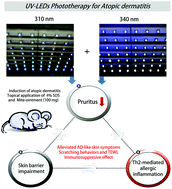当前位置:
X-MOL 学术
›
Photochem. Photobiol. Sci.
›
论文详情
Our official English website, www.x-mol.net, welcomes your
feedback! (Note: you will need to create a separate account there.)
Irradiation with 310 nm and 340 nm ultraviolet light-emitting-diodes can improve atopic dermatitis-like skin lesions in NC/Nga mice†
Photochemical & Photobiological Sciences ( IF 2.7 ) Pub Date : 2018-07-13 00:00:00 , DOI: 10.1039/c8pp00063h Tae-Rin Kwon 1, 2, 3, 4 , Jong Hwan Kim 1, 2, 3, 4, 5 , Ji-Yeon Hong 1, 2, 3, 4, 5 , Joon Seok 1, 2, 3, 4, 5 , Jae Min Kim 1, 2, 3, 4, 5 , Dong-Ho Bak 1, 2, 3, 4, 5 , Mi-Ji Choi 1, 2, 3, 4, 5 , Seok Kyun Mun 2, 3, 4, 6 , Chan Woong Kim 2, 3, 4, 7 , Beom Joon Kim 1, 2, 3, 4, 5
Photochemical & Photobiological Sciences ( IF 2.7 ) Pub Date : 2018-07-13 00:00:00 , DOI: 10.1039/c8pp00063h Tae-Rin Kwon 1, 2, 3, 4 , Jong Hwan Kim 1, 2, 3, 4, 5 , Ji-Yeon Hong 1, 2, 3, 4, 5 , Joon Seok 1, 2, 3, 4, 5 , Jae Min Kim 1, 2, 3, 4, 5 , Dong-Ho Bak 1, 2, 3, 4, 5 , Mi-Ji Choi 1, 2, 3, 4, 5 , Seok Kyun Mun 2, 3, 4, 6 , Chan Woong Kim 2, 3, 4, 7 , Beom Joon Kim 1, 2, 3, 4, 5
Affiliation

|
Ultraviolet (UV) light produces an immunomodulatory effect on the skin and is widely used for the treatment of chronic inflammatory skin diseases. UV light emitting diodes (UV-LEDs) are a new and promising source of UV radiation. However, their mechanism of action remains largely unknown. In this study, we tested the safety and effectiveness of UV-LED irradiation for the treatment of atopic dermatitis (AD) in an NC/Nga mouse model. Mice were divided into seven groups of eight mice each. Application of Dermatophagoides farinae (Df) extract ointment for four weeks induced AD-like skin lesions. Subsequently, the mice were exposed to UV-LEDs, narrow band UVB, or UVA irradiation three times per week. We assessed the immunosuppressive effects of 310 nm (50 mJ cm−2) and 340 nm (5 J cm−2) UV-LED irradiation. Histological analyses using hematoxylin–eosin, toluidine blue, and immunohistochemical staining were performed. In addition, the serum levels of IgE, inflammatory cytokines and chemokines were measured using enzyme-linked immunosorbent assays (ELISAs). UV-LED irradiation significantly alleviated AD-like skin symptoms, including edema, erythema, dryness, and itching, by modulating Th1 and Th2 responses, transepidermal water loss (TEWL), and scratching behavior in NC/Nga mice. These results suggest that UV-LEDs can improve the treatment of inflammatory skin diseases.
中文翻译:

用310 nm和340 nm紫外发光二极管进行辐照可以改善NC / Nga小鼠的特应性皮炎样皮肤病变†
紫外线(UV)对皮肤产生免疫调节作用,被广泛用于治疗慢性炎症性皮肤病。紫外线发光二极管(UV-LED)是一种新的有希望的紫外线辐射源。但是,它们的作用机理仍然未知。在这项研究中,我们测试了UV / LED辐射在NC / Nga小鼠模型中治疗特应性皮炎(AD)的安全性和有效性。将小鼠分成七组,每组八只小鼠。应用法氏皮肤癣菌(Df)提取物软膏持续四周可诱发AD样皮肤病变。随后,每周将小鼠暴露于UV-LED,窄带UVB或UVA照射下3次。我们评估了310 nm(50 mJ cm -2)和340 nm(5 J cm-2)UV-LED照射。使用苏木精-曙红,甲苯胺蓝和免疫组化染色进行组织学分析。另外,使用酶联免疫吸附测定(ELISA)测量血清IgE,炎性细胞因子和趋化因子的水平。UV-LED辐射可通过调节Th1和Th2反应,经皮失水(TEWL)和NC / Nga小鼠的抓挠行为来显着缓解AD样皮肤症状,包括水肿,红斑,干燥和瘙痒。这些结果表明UV-LED可以改善炎性皮肤疾病的治疗。
更新日期:2018-07-13
中文翻译:

用310 nm和340 nm紫外发光二极管进行辐照可以改善NC / Nga小鼠的特应性皮炎样皮肤病变†
紫外线(UV)对皮肤产生免疫调节作用,被广泛用于治疗慢性炎症性皮肤病。紫外线发光二极管(UV-LED)是一种新的有希望的紫外线辐射源。但是,它们的作用机理仍然未知。在这项研究中,我们测试了UV / LED辐射在NC / Nga小鼠模型中治疗特应性皮炎(AD)的安全性和有效性。将小鼠分成七组,每组八只小鼠。应用法氏皮肤癣菌(Df)提取物软膏持续四周可诱发AD样皮肤病变。随后,每周将小鼠暴露于UV-LED,窄带UVB或UVA照射下3次。我们评估了310 nm(50 mJ cm -2)和340 nm(5 J cm-2)UV-LED照射。使用苏木精-曙红,甲苯胺蓝和免疫组化染色进行组织学分析。另外,使用酶联免疫吸附测定(ELISA)测量血清IgE,炎性细胞因子和趋化因子的水平。UV-LED辐射可通过调节Th1和Th2反应,经皮失水(TEWL)和NC / Nga小鼠的抓挠行为来显着缓解AD样皮肤症状,包括水肿,红斑,干燥和瘙痒。这些结果表明UV-LED可以改善炎性皮肤疾病的治疗。











































 京公网安备 11010802027423号
京公网安备 11010802027423号